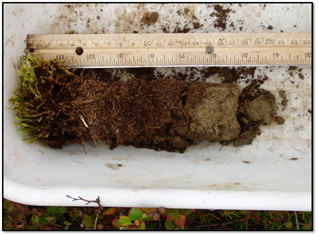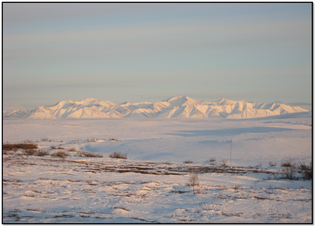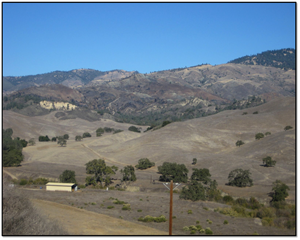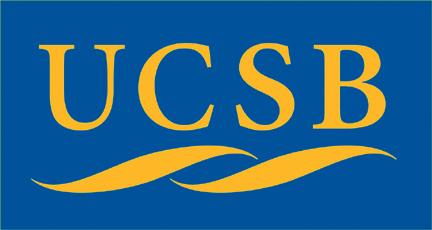|
|
My research sits at the interface of ecosystem and microbial ecology. I am interested in the role of soil microbes in controlling ecosystem scale processes. I am particularly interested in the linkages between plant and soil processes, and how changes in microbial community structure affects ecosystem-scale dynamics. My work is now focusing on three ecosystems: the Arctic tundra in Alaska and Greenland, High elevation ecosystems in the Sierra Nevada, and the California annual grassland-oak savanna.
 Work in the Arctic is focused on understanding the dynamics of soil organic matter. The Arctic is important in global climate since there is a lot of C stored in arctic soils and the Arctic is warming faster than the rest of the world. Increased temperatures could cause greater release of C into the atmosphere, producing a positive feedback on global climate. Alternatively, nutrient release from soil organic matter could enhance plant growth, making the Arctic a stronger sink for atmospheric CO2, and producing a negative feedback on climate. Which of these processes is more important depends on the nature of soil organic matter, its bioavailability, and what happens to the nutrients that are made available by decomposition. Within this framework I have projects studying the bioavailability of tundra soil C and N and how that varies throughout the year. Work in the Arctic is focused on understanding the dynamics of soil organic matter. The Arctic is important in global climate since there is a lot of C stored in arctic soils and the Arctic is warming faster than the rest of the world. Increased temperatures could cause greater release of C into the atmosphere, producing a positive feedback on global climate. Alternatively, nutrient release from soil organic matter could enhance plant growth, making the Arctic a stronger sink for atmospheric CO2, and producing a negative feedback on climate. Which of these processes is more important depends on the nature of soil organic matter, its bioavailability, and what happens to the nutrients that are made available by decomposition. Within this framework I have projects studying the bioavailability of tundra soil C and N and how that varies throughout the year.
 One important piece of understanding the Arctic is winter. Winter is long and cold, but it is not biologically dead. Winter activity accounts for a significant portion of total annual respiration, and may account for all of the annual net C efflux. Nitrogen cycling under the snow may also be important in supplying nitrogen to plants. We actually know very little about the controls on microbial activity in freezing and frozen soils. This project is part of the ATLAS (Arctic Transitions in the Land-Atmosphere System) program; a component of the NSF Polar Programs, Land-Atmosphere-Ice Interactions program. This is a large, interdisciplinary program focused on understanding the Arctic as an integrated system, with strongly interacting physical and biological components. One important piece of understanding the Arctic is winter. Winter is long and cold, but it is not biologically dead. Winter activity accounts for a significant portion of total annual respiration, and may account for all of the annual net C efflux. Nitrogen cycling under the snow may also be important in supplying nitrogen to plants. We actually know very little about the controls on microbial activity in freezing and frozen soils. This project is part of the ATLAS (Arctic Transitions in the Land-Atmosphere System) program; a component of the NSF Polar Programs, Land-Atmosphere-Ice Interactions program. This is a large, interdisciplinary program focused on understanding the Arctic as an integrated system, with strongly interacting physical and biological components.

In California a major program is targeted at understanding the functioning of California annual grassland oak savanna/woodland ecosystems. Within this larger direction, I have two project thrusts. One is focusing on plant soil interactions and how changing plant communities interact with changing soil processes, particular nitrogen cycling. In particular we are interested in the effect of the annual grasses that invaded California starting over 100 years ago. How much of their success is through changing soil conditions? We are working with Dr. Jim Reichman, Eric Seabloom, and Oliver Chadwick on this work. The other thrust is understanding how stress (drying/rewetting) and resource availability through the soil profile regulate microbial diversity, community composition, and community function. This project is basic microbial ecology and includes work using molecular tools to understand the dynamics of specific microbial populations.
|
|
| |
 |
|
.
|
|
|

 Work in the Arctic is focused on understanding the dynamics of soil organic matter. The Arctic is important in global climate since there is a lot of C stored in arctic soils and the Arctic is warming faster than the rest of the world. Increased temperatures could cause greater release of C into the atmosphere, producing a positive feedback on global climate. Alternatively, nutrient release from soil organic matter could enhance plant growth, making the Arctic a stronger sink for atmospheric CO2, and producing a negative feedback on climate. Which of these processes is more important depends on the nature of soil organic matter, its bioavailability, and what happens to the nutrients that are made available by decomposition. Within this framework I have projects studying the bioavailability of tundra soil C and N and how that varies throughout the year.
Work in the Arctic is focused on understanding the dynamics of soil organic matter. The Arctic is important in global climate since there is a lot of C stored in arctic soils and the Arctic is warming faster than the rest of the world. Increased temperatures could cause greater release of C into the atmosphere, producing a positive feedback on global climate. Alternatively, nutrient release from soil organic matter could enhance plant growth, making the Arctic a stronger sink for atmospheric CO2, and producing a negative feedback on climate. Which of these processes is more important depends on the nature of soil organic matter, its bioavailability, and what happens to the nutrients that are made available by decomposition. Within this framework I have projects studying the bioavailability of tundra soil C and N and how that varies throughout the year.  One important piece of understanding the Arctic is winter. Winter is long and cold, but it is not biologically dead. Winter activity accounts for a significant portion of total annual respiration, and may account for all of the annual net C efflux. Nitrogen cycling under the snow may also be important in supplying nitrogen to plants. We actually know very little about the controls on microbial activity in freezing and frozen soils. This project is part of the ATLAS (Arctic Transitions in the Land-Atmosphere System) program; a component of the NSF Polar Programs, Land-Atmosphere-Ice Interactions program. This is a large, interdisciplinary program focused on understanding the Arctic as an integrated system, with strongly interacting physical and biological components.
One important piece of understanding the Arctic is winter. Winter is long and cold, but it is not biologically dead. Winter activity accounts for a significant portion of total annual respiration, and may account for all of the annual net C efflux. Nitrogen cycling under the snow may also be important in supplying nitrogen to plants. We actually know very little about the controls on microbial activity in freezing and frozen soils. This project is part of the ATLAS (Arctic Transitions in the Land-Atmosphere System) program; a component of the NSF Polar Programs, Land-Atmosphere-Ice Interactions program. This is a large, interdisciplinary program focused on understanding the Arctic as an integrated system, with strongly interacting physical and biological components. 
